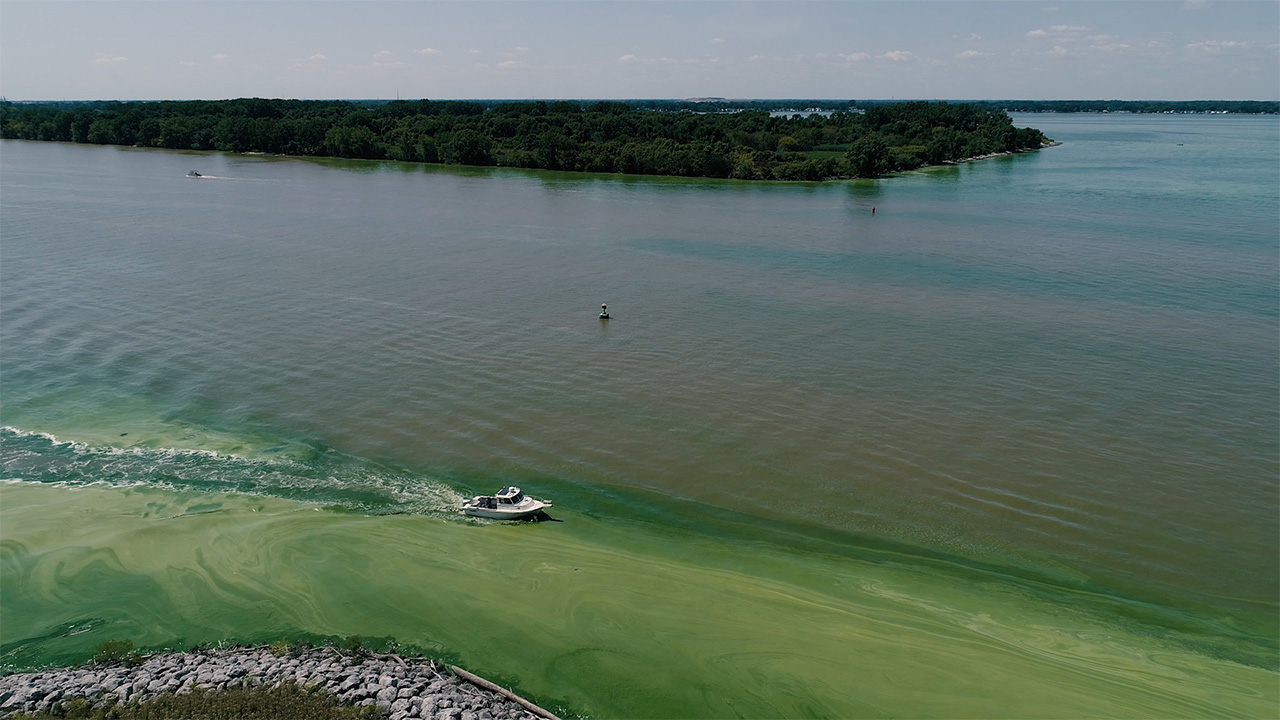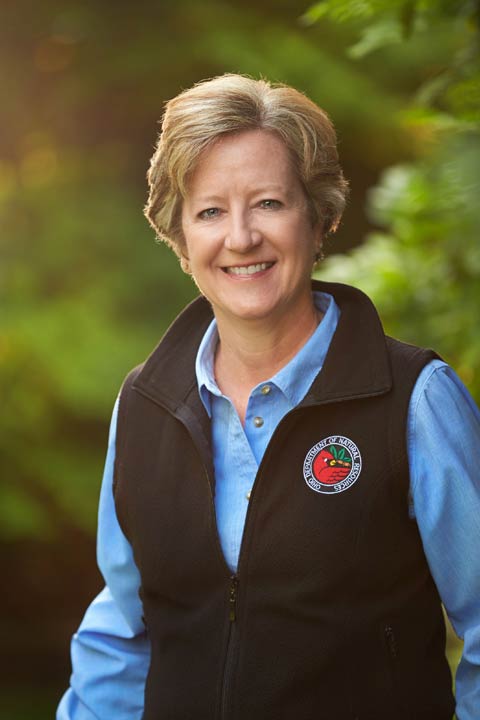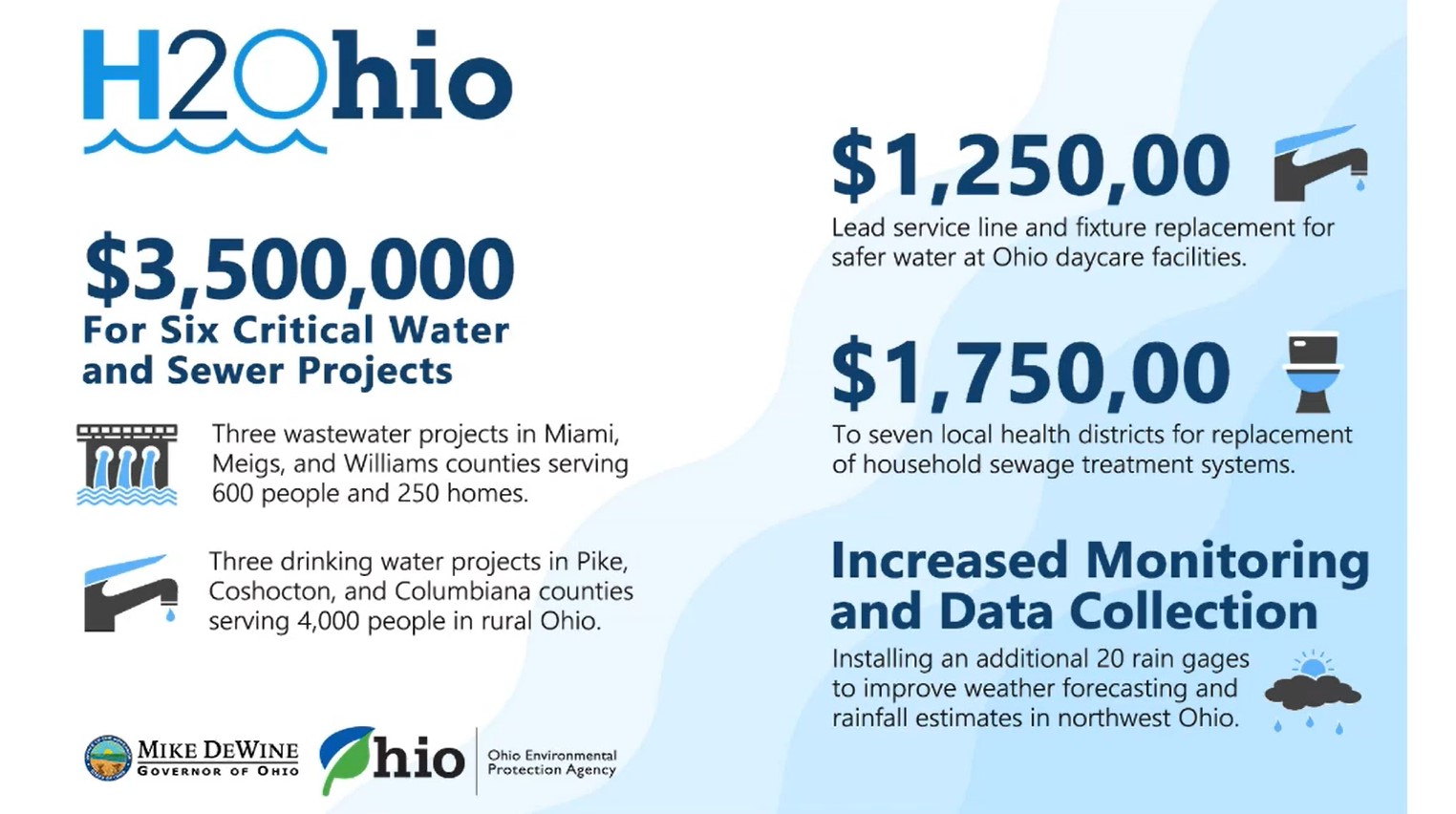
The first full-year report for Ohio Gov. Mike DeWine’s much-publicized H2Ohio water quality initiative is out.
Introduced in 2019, the plan has already reaped benefits for Ohio residents and will continue to expand in its scope, according to officials charged with its implementation.
The report was offered in a web presentation by Ohio Department of Agriculture Director Dorothy Pelanda, Ohio Department of Natural Resources Director Mary Mertz and Ohio Environmental Protection Agency Director Laurie Stevenson.
Combined, the three agencies will seek $240.85 million in funding during the upcoming two-year budget.
House Bill 7, passed in December, will bolster the original H2Ohio legislation, according to officials. Provisions of the bill direct Pelanda to appoint watershed coordinators to each of Ohio’s seven watershed districts. Those coordinators will be responsible for identifying areas where water is impaired – including the sources of pollution – and engaging in planning to restore, protect and manage water resources in their districts.

Ohio Department of Agriculture Director Dorothy Pelanda
“The governor just signed this bill into law very recently and so we’re still studying it,” Pelanda said. “The provisions and obligations rest squarely with the ODA and we have a great team that is digesting it. The statute is very specific about the coordinators – education and experience and duties. The bill also requires the coordinators to issue a report to the director as to what they’re finding in that particular watershed, so it’s all about gathering data, sharing data and moving forward in a very purposeful manner.”
Cooperating with farmers is a key part of H2Ohio’s plan to improve water quality and eliminate the algae issues on Lake Erie. Significant funds have been committed toward working with producers to implement a group of seven best management practices on Ohio landscapes. Currently 1 million acres are enrolled in the programs that subsidize participating farmers for their actions.
The seven practices are soil testing and voluntary nutrients management plans, variable rate application, subsurface placement, manure incorporation, crop rotation, cover crops, and water drainage management.
“In essence this first year we offered to pay producers at the rate of about $40 per acre for one or more of these practices, however each and every one of the producers must engage in the very first one, which is to create a voluntary nutrients management plan as the basis for their program going forward,” Pelanda said of farmers in the original 14 H2Ohio counties in the Maumee River watershed. “Most all the producers engaged in two or more of the practices. We have over 500 water drainage management systems under construction at this point.”
During 2020, 43% of total cropland in the Maumee River watershed was enrolled in H2Ohio. Pelanda said expanding from the original 14 counties to 24 total counties is on tap this year.
Pelanda will request $98.6 million in ODA funding for the upcoming two-year budget.
Related stories on Great Lakes Now:
Field Tiles: Continued use and improvement of drainage systems pose problems for Lake Erie
Total Maximum Daily Load: Court case looks to push for Ohio EPA nutrients limit for Lake Erie
ODNR engaged wetlands water quality projects

Ohio Department of Natural Resources Director Mary Mertz
The ODNR has been working on projects revolving mostly around wetlands. Mertz said natural infrastructure will play a role in H2Ohio and, under her purview, that means marshes.
Creating and improving wetlands at critical sites in western basin watersheds will help filter and settle nutrients before they enter the lake, reducing the phosphorus ending up in the lake, Mertz said.
“The 44 projects are what we’ve committed to so far,” she explained. “Some of the wetlands are complete and some will be completed this spring, so all of those will be producing benefits. Others are more sophisticated, still in design stages, and will take longer for completion. Hopefully if we get funding in the upcoming budget this map will expand exponentially.”
Of the 33 wetlands-related H2Ohio projects, 19 are concentrated on or near the western basin, while another 14 are upstream in the Maumee River watershed. According to Mertz, about 20 non-profit groups have partnered with the ODNR to help design and construct wetlands, most of which are not on state-owned land.

H2Ohio statewide projects (Ohio DNR graphic)
“I think we’ve exhausted some of them,” Mertz said of the groups and their contractors. “I think some of them are looking to hire more people to do these projects because we’re moving at a great rate. I don’t think you’ve seen this anywhere in the country, this level of concentration and this level of state reinvestment. We want to keep everyone busy.”
In addition to nutrients reduction benefits, Mertz said, there are the recreational and wildlife contributions wetlands make. In Ohio, more than 90 threatened and endangered species depend on wetlands habitat for survival.
In the upcoming budget the ODNR has asked for $50 million to help fund wetlands efforts.
H2Ohio goals include more than just Maumee watershed, Lake Erie algae
The OEPA’s focus with H2Ohio is statewide and features projects in both rural and urban areas, as the OEPA extends the projects to the rest of the state.
“When you hear the governor talk about his vision for H2Ohio, it’s focused on Lake Erie and improving conditions in the western basin, but it’s also more broadly focused on making water quality conditions better in other areas of the state for the benefit of all Ohioans,” Stevenson said. “So when we look at H2Ohio, the EPA’s work, we’re focused on different areas including infrastructure throughout Ohio.”
H2Ohio’s to-do list for the OEPA includes replacement of lead lines serving schools and daycares; repair and replacement of some failing residential septic systems; and a number of drinking water and municipal sewage treatment projects.
And lead lines are at the forefront.

(Ohio EPA graphic)
“We’re going to focus on schools and daycares certainly for the immediate future,” Stevenson said, going on to explain that the first lead remediation targets should be at sites where children congregate and are susceptible.

Ohio Environmental Protection Agency Director Laurie Stevenson
According to Stevenson, multiple communities are currently exploring options regarding programs to remediate lead service lines. For the OEPA, measuring the success of H2Ohio comes down to the people.
“How many people are we supporting by getting them, where they had a failing system, onto systems where they now have clean water, or where they have adequate ways to address sewage and wastewater treatment?” she said. “From a water quality perspective, when it comes to failing home septic systems we may not see a dramatic reduction in nutrient loads from our activities, but we have other concerns like reducing exposure to E-coli and other harmful bacteria. We do have some of the data we can certainly overlay onto of our efforts, but we can also look at it through the lens of how many people are we assisting directly through the infrastructure improvements we’re making.”
The OEPA is requesting $92 million in the upcoming budget.
Subsides, partnerships may help
Producers’ future reliance on technology to achieve water quality goals will be an undoubtedly expensive part of the equation.
In a 2020 GLN article on farmers’ conservation costs, Toledo-area farmer Bill Myers said he spends about $55 to $60 an acre each year on BMPs. An implement that injects nutrients beneath the soil surface often runs in excess of $100,000. And the use of software that controls nutrients applicators can set a farmer back about $25,000.
Pelanda conceded the added costs are significant for Ohio farmers.
“The machines that incorporate nutrients sub-surface are expensive, we know that,” she said. “We know that incorporating manure and fertilizer is one of the most effective ways of keeping nutrients on the land. So we’ll continue to study the data and continue to work with retailers and businesses to see if they can help.”
According to Stevenson, the OEPA will be reviewing new technologies and innovative ideas that could help agricultural producers meet conservation goals.
“We’re building things a little bit as we head down the runway, but we certainly want to daylight some of those technologies,” she said. “Right now we’re just in the process of evaluating what comes through the door with our third-party vendors to see what shakes out of that.”
Ohio officials, in the search for solutions, invite proposals and ideas that could be used to mitigate these issues and improve water quality.
“We’re well under way in our technology proposals, and we’re hoping we can continue to support more idea vetting or potentially some larger-scale demonstration projects with those technologies that come out of this process and have some real potential of being feasible moving forward,” Stevenson said.
And student participation might have been dampened by COVID-19, but schools are still involved in the projects.
“It’s been an odd year because of COVID, but we’ve still connected with four schools in northwest Ohio and one in central Ohio,” Mertz said. “Our original vision was kids would get out there where we’re building the wetlands and they’d be part of it and would assist with experiments and monitoring and be really engaged.”
Instead, she said, students from Ranger High-Tech Academy, Aerospace & Natural Science Academy of Toledo, and Clay, Ottawa Hills and Granville high schools have participated virtually, including the creation of educational signage for wetlands projects.
“There’s still a great future and we all know it’s important for youth to be exposed to these grand experiments we’re undertaking and to be part of making a difference and to encourage them to be a part in the future,” Mertz said.
Western Basin H2Ohio to be judged by scientists
According to Mertz, members of the Lake Erie and Aquatic Research Network are developing a plan to monitor and assess data regarding water quality, specifically nutrients management, in the Maumee River watershed as well as H2Ohio’s successes or failures.
“This is the group that’s going to hold us accountable,” she said during the web conference on the report. “They’ll report to all of you on their findings in the coming years. These are all of the leading higher education institutions who are putting together monitoring protocol.”
Researchers will assess the efficacy of the conservation efforts on an ongoing basis, Mertz said.
The current goal is to reduce phosphorous loads entering Lake Erie by 40% by 2025.
Catch more news on Great Lakes Now:
H2Ohio: Ohio governor’s plan puts $1 billion toward clean water and new wetlands
Too few farmers are curbing pollution in Lake Erie. Should they be forced?
Highlights of Ohio governor’s proposed 2-year spending plan
API key not valid. Please pass a valid API key.Featured image: Harmful algal bloom in western Lake Erie (Great Lakes Now Episode 1013)




